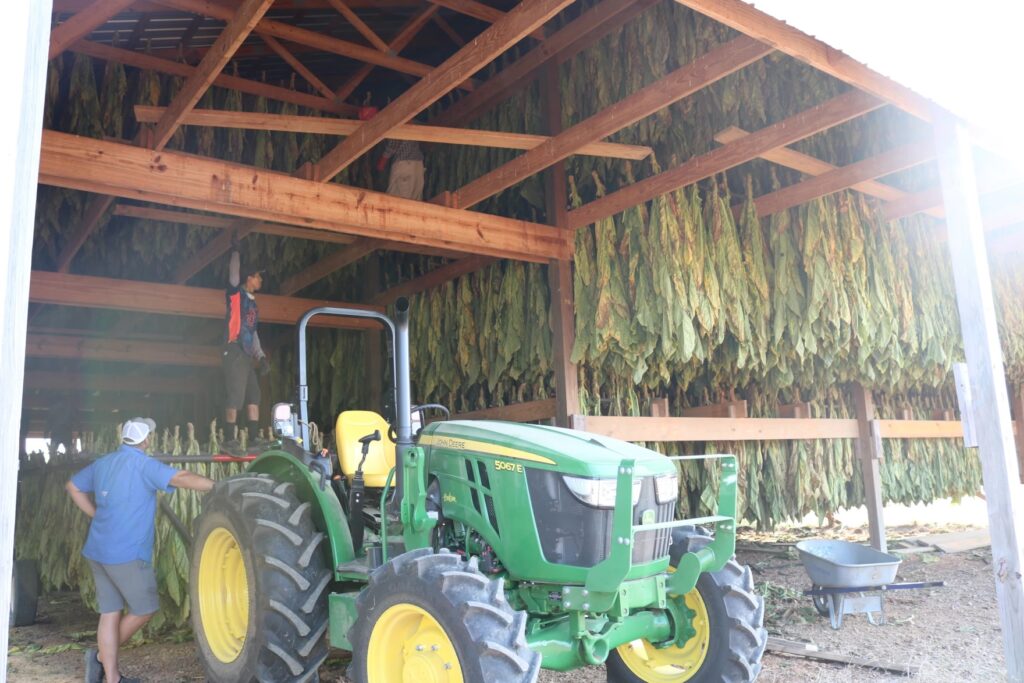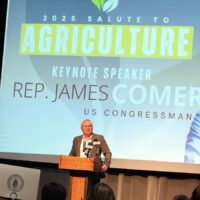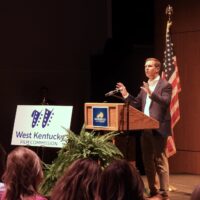The late summer heat in Kentucky often brings with it the smell of tobacco.
The plant has been a cash crop for the Bluegrass State for well over a century and, every August and September, smoke billows from barns where farmers and their families have cut, hung and cured their tobacco crops for decades.

Scott Lowe farms 800 acres of Calloway County land in far Western Kentucky. He and his family grow corn, wheat and soybeans, and tend a small cattle herd. The first-generation farmers also grow dark-fire and dark-air cured tobacco, which Lowe described as his family’s “bread and butter.”
“My family is first generation farmers, and so we started from the ground up, and it’s been a challenging road, I guess you’d say, but it’s been very rewarding at the same time,” Lowe said. “It’s been a good crop for us and been a good crop for a lot of people in our region.”
Lowe learned the trade while working as a laborer on a neighbor’s farm in high school and he grew his first crop of dark-fire tobacco in 2002.
At the time, there were a little more than 29,000 tobacco farms in Kentucky. Today, there are fewer than a thousand.
Industry experts say the decline of what was once one of Kentucky farms’ top crops coincides with shifts in tobacco consumption habits and to the long tail effect of the Fair and Equitable Tobacco Reform Act signed into law by former President George W. Bush 20 years ago this month.
The law ended restrictions on the amount of tobacco farmers could sell at a federally-guaranteed rate and ended practices like marketing cards and price support loans in the industry.

‘Tobacco was king’
The history of tobacco in America starts long before the country was founded, with some historians suggesting that early native populations living in what would become the United States were smoking it in pipes as early as 3000 B.C.E.
European settlers started cultivating the crop not long after coming to the continent, and it became a key product of the American economy. Farmers that settled in Kentucky found that it flourished in the state’s climate and soil, and trade took off once commercial routes along local waterways were developed.
In the aftermath of the Great Depression, prices for most agricultural products – including tobacco – were so low that the government put together a series of programs through the Agricultural Adjustment Act of 1938 to help increase prices and income for agricultural producers.
The program had a quota system that limited the amount of tobacco an individual farmer could produce, enabling the government to control the supply and ensure producers that prices would remain at a suitable level.
Each year, tobacco that didn’t sell at an acceptably high rate would be bought at the government-guaranteed price. Those purchases were made using loaned funds from the USDA’s Commodity Credit Corporation that was borrowed against money from the U.S. Treasury. These payments had to be made up with interest. In Kentucky, the Burley Tobacco Growers Cooperative would store the tobacco until it could be resold at a higher price, and those funds would be used to pay off the loan.
Will Snell, an agricultural economist at the University of Kentucky, called it a “very successful federal program” for the time.
“We had some good years and bad years in tobacco, but it kept tobacco prices at a level which enabled it to be very profitable for most every farm in Kentucky [that] had a tobacco quota,” Snell said.
The economist said that the program started to go into decline in the late 1980s, when U.S. tobacco prices got too high and couldn’t keep competitive with the international market. To address that, the program reduced farmers’ quotas. This meant any farmer who wanted to up their tobacco production or start growing the crop would have to go through the complicated process of renting the right from farmers who weren’t using their set quotas.
“The bottom line is, the program was not working,” Snell said. “We spent about 10-15 years trying to patch the existing program but, at the end of the day, our congressional delegation was able to get a buyout of the program.”
When the reform passed in 2004, the U.S. Department of Agriculture created the Tobacco Transition Payment Program – often called the Tobacco Buyout program. That provided payments to tobacco quota holders and producers through 2014 to make up for lost income that came with the guaranteed quotas.
While most buyouts are paid for through taxes, the tobacco buyout was funded by tobacco companies who raised prices on their products to pay it off, Snell explained. He said that shift from the quota system saw a lot of tobacco producers leave the crop behind. Since those quotas were no longer in place, farmers and companies that wanted to grow tobacco could consolidate operations to create one larger producer rather than running operations on multiple farms.
Census of Agriculture data from the USDA shows that Kentucky had more than 136,000 working tobacco farms in the early 1950s. The evolution of large-scale farming saw that number fall to just under 62,000 by 1987. It halved again by the creation of the buyout and, in 2022, just 984 operations were still growing the crop in the Commonwealth.
David Knopf is a regional director for the National Agricultural Statistics Service, part of the USDA. He said that tobacco accounted for, on average, more than one-third of Kentucky’s annual gross agricultural revenue between 1924 and 1974. In the 1990s, tobacco still made up about 25% of Kentucky’s agricultural profits.
“At one time, tobacco was king,” Knopf said. “When we look at the number of growers in the state, at one time more than half of the farms in Kentucky grew tobacco and today … just a little bit more than 1% of the farms in Kentucky now grow tobacco.”
Now – 20 years after the reform was passed and 10 years after the end of the buyout – Knopf said that tobacco represents just about 3% of the state’s agricultural profits.

‘A lot of changes going on’
Since Scott Lowe started farming tobacco – just before the buyout program was enacted – he and his family have never had a quota for the crop. While that meant they weren’t entitled to buyout payments, it meant they could grow as much tobacco as they saw fit for their operation.
“When the buyout went through, I’ve got mixed emotions,” Lowe said. “It’s a good thing and a bad thing, I guess, all in one breath, but it gave us our start.”
Since Lowe started his farm, trends in the regional tobacco production and increases in production costs for the crop have been a big factor in the industry.
Labor costs are one of the biggest shifts for growers like Lowe. Tobacco can be a labor intensive crop because it has to be cut by hand – and at many farms, it also has to be hung up to dry by workers. Some types of tobacco also must have the leaves stripped from the stalk manually.
“Making a good yield and managing your labor is becoming more and more of a key factor in being successful as a tobacco farm,” Lowe said.
He uses H-2A workers hired through a temporary employment program for migrant workers overseen by the U.S. Department of Labor. The government controls the wage rate in this program. Other input costs include seeds and fertilizer.
Many farmers are also experiencing lower yields per acre, which means less pounds to sell to companies.
Snell said that more tobacco is now grown in Western Kentucky than in the traditional Bluegrass region of the state in central kentucky. He also said that more farmers are growing dark-fired or dark-air cured tobacco – like Lowe grows – as opposed to burley tobacco. Burley tobacco is most commonly used in cigarettes, while dark-fired or dark-air cured tobacco is most commonly used in smokeless tobacco products.
Changes in the regulations and mandates around the sales and use of tobacco have also made it harder to turn a profit with the crop.
The United States Surgeon General released the first report on smoking and public health in 1964. Shortly thereafter, the U.S. Congress started to pass laws related to the labels and advertisements for cigarettes, and called for an annual report on smoking’s impact on public health.
The Centers for Disease Control and Prevention Office on Smoking and Health has gone on to produce nearly 30 more reports on smoking. The ongoing reports have documented a continuing decline in the number of tobacco smokers in the U.S. population. According to the American Lung Association, while smokeless tobacco use isn’t high, it hasn’t decreased in recent years.
Data from the American Lung Association shows that smoking among U.S. adults fell 73% between 1965 and 2022. CDC data shows that, in 1965, 42% of American adults smoked cigarettes. By 2023, only a little under 12% of adults in the country were smoking cigarettes.
Gallup polling from 2023 found that the U.S. smoking rate is remaining steady near its historical low, tying the decrease in smokers to more Americans heeding the warnings about the health dangers of the practice and most public places prohibiting it.
While statistics show that producers and users have been leaving tobacco behind, the experience of leaving the crop behind is very personal for some farmers.

Christian County farmer Dale Seay pulled the plug on his tobacco growing operation this year after more than 50 harvests. The 68-year-old still grows other crops like corn and soybeans, but said leaving tobacco behind was a “hard decision.”
“Probably one of the hardest things I’ve ever done, but it had to be a financial decision,” Seay said. “We’re fighting a lot of issues out here in the tobacco industry, from weather to prices to you name it, a lot of things going on in the tobacco industry … a lot of changes going on.”
Seay learned the trade from his father, who farmed tobacco before him. He said there was a shift away from the tradition of passing farming operations from generation to generation as corporate and large-scale farming operations took over the industry.
“It used to be family farms,” Seay said. “Everybody had two or three acres or something, and it was done on the farm with family help and everything, and it helps send kids to college and different things.”
Seay was farming tobacco when the buyout happened in 2004. Initially, he liked being able to directly negotiate with companies that wanted to buy his crop. But as time went on, the production became too expensive and the revenues shrank. He said he doesn’t think many young farmers will choose to grow the crop moving forward for the same reasons he got out of the business.
“It’s going to be hard, if they need the crop, to find somebody to grow it someday because [at] our age, we’re ready to give it up – whether it’s for our age or for financial reasons, whatever,” Seay said. “Younger people – I think some of them are smarter than some of us older guys – they’re not going to do it just for the fun of it or just because it was a way of life. They’ve got to make money doing it, and that’s the way it should be.”
Up in smoke?
Joe Cain grew up on a tobacco and dairy farm in Lincoln County, Kentucky.
Now, he works as the executive director of the Burley and Dark Tobacco Producers Association, a grower’s group that evolved out of an older burley tobacco growers’ syndicate. The group represents the interests of tobacco producers on legislative, regulatory and marketing issues. It does things like working with companies to improve market situations for growers or helping members navigate labor regulations.

He was involved in the tobacco industry when the buyout happened and has noted the trend of smaller farming operations being acquired since then.
“We’re seeing a consolidation of acreage, so you’re seeing a lot more larger growers and a lot fewer small growers, so you’re seeing that consolidation, and that’s a direct result of the buyout, and then going to the contract basis for leaf,” Cain said.
Cain, who also works with the Kentucky Agricultural Council, said the future of tobacco isn’t entirely certain. He thinks the plant could play a role in medical research related to diseases like cancer and ebola, but he also expects to see even more consolidation among the top companies and fewer growers in the tobacco game overall. Despite a perceived decrease in overall demand for tobacco products in the U.S., Cain is staying optimistic for the industry.
“I think we’ll always have people that will smoke, that will choose to smoke, that will choose to use the smokeless products, at least in the foreseeable future,” Cain said. “So in my opinion, we’re going to always have a demand for U.S. grown leaf.”
He also saw what other people have seen as a consequence of the reform – other agricultural industries seeing growth from the buyout funds.
Seay, the Christian County farmer who’s stopped growing the crop, said he’s heard companies want to switch to mostly smokeless products, meaning there’s likely to be significantly less burley tobacco grown.
“There’s all kinds of products out there, but hopefully dark-fire tobacco or dark-air cured tobacco, or some of those things, I think there’ll still be some needed,” Seay said. “But the day, as we knew it growing up, is over for the tobacco plant itself.”
Seay said that he suspected that the average age for most tobacco farmers is getting older – like Kentucky farmers in general. Because of that, he expects more and more older farmers will stop growing the crop. Seay said it will also depend on what the companies decide to do.
Lowe, the farmer from Calloway County, said he thinks tobacco farming “is going to be around for forever” and plans to pass his farm down to his children.
“I think it’s something we have to do: to learn to adapt to all the changes, all the mandates, all the regulations, but every year there’s something new, and we just adapt and keep rolling,” Lowe said. “There’s always going to be a need for tobacco.”
Lily Burris is a features reporter for WKMS. She has a bachelor's degree in journalism from Western Kentucky University. She has written for the College Heights Herald at WKU, interned with Louisville Public Media, served as a tornado recovery reporter with WKMS and most recently worked as a journalist with the Kentucky Center for Investigative Reporting. In her free time, she enjoys reading, crocheting and baking.





